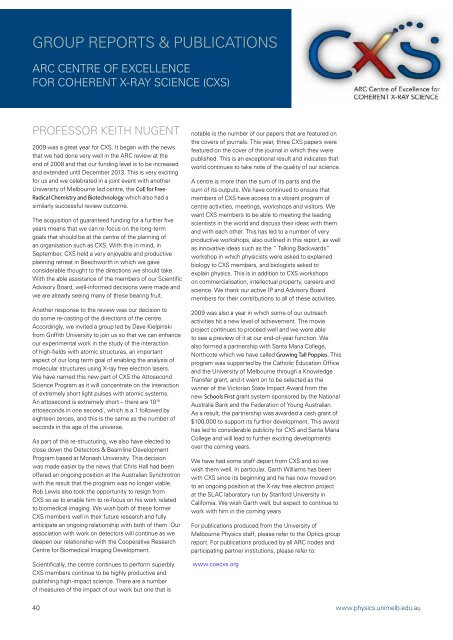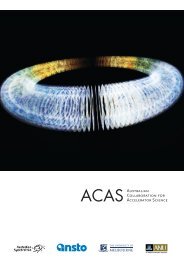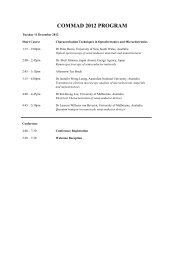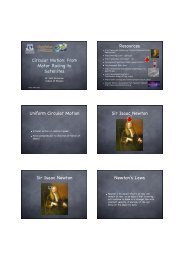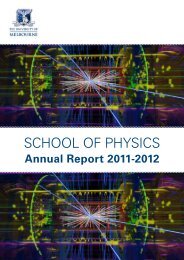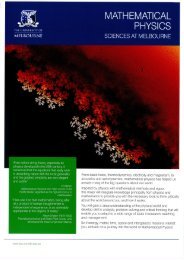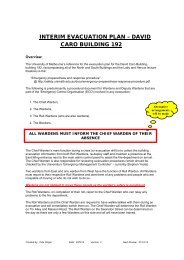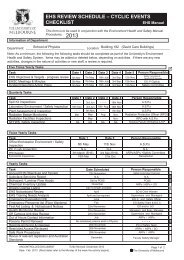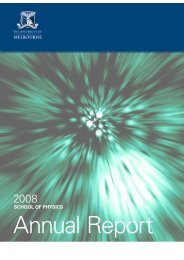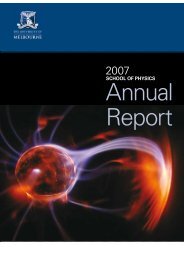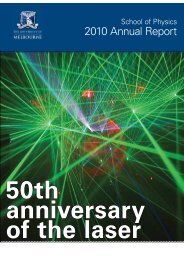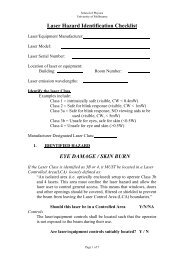Annual Report 2009.pdf - School of Physics - University of Melbourne
Annual Report 2009.pdf - School of Physics - University of Melbourne
Annual Report 2009.pdf - School of Physics - University of Melbourne
- No tags were found...
Create successful ePaper yourself
Turn your PDF publications into a flip-book with our unique Google optimized e-Paper software.
group reports & publicationsarc centre <strong>of</strong> excellencefor coherent x-ray science (CXS)Pr<strong>of</strong>essor Keith Nugent2009 was a great year for CXS. It began with the newsthat we had done very well in the ARC review at theend <strong>of</strong> 2008 and that our funding level is to be increasedand extended until December 2013. This is very excitingfor us and we celebrated in a joint event with another<strong>University</strong> <strong>of</strong> <strong>Melbourne</strong> led centre, the CoE for Free-Radical Chemistry and Biotechnology which also had asimilarly successful review outcome.The acquisition <strong>of</strong> guaranteed funding for a further fiveyears means that we can re-focus on the long-termgoals that should be at the centre <strong>of</strong> the planning <strong>of</strong>an organisation such as CXS. With this in mind, inSeptember, CXS held a very enjoyable and productiveplanning retreat in Beechworth in which we gaveconsiderable thought to the directions we should take.With the able assistance <strong>of</strong> the members <strong>of</strong> our ScientificAdvisory Board, well-informed decisions were made andwe are already seeing many <strong>of</strong> these bearing fruit.Another response to the review was our decision todo some re-casting <strong>of</strong> the directions <strong>of</strong> the centre.Accordingly, we invited a group led by Dave Kielpinskifrom Griffith <strong>University</strong> to join us so that we can enhanceour experimental work in the study <strong>of</strong> the interaction<strong>of</strong> high-fields with atomic structures, an importantaspect <strong>of</strong> our long term goal <strong>of</strong> enabling the analysis <strong>of</strong>molecular structures using X-ray free electron lasers.We have named this new part <strong>of</strong> CXS the AttosecondScience Program as it will concentrate on the interaction<strong>of</strong> extremely short light pulses with atomic systems.An attosecond is extremely short – there are 10 18attoseconds in one second , which is a 1 followed byeighteen zeroes, and this is the same as the number <strong>of</strong>seconds in the age <strong>of</strong> the universe.As part <strong>of</strong> this re-structuring, we also have elected toclose down the Detectors & Beamline DevelopmentProgram based at Monash <strong>University</strong>. This decisionwas made easier by the news that Chris Hall had been<strong>of</strong>fered an ongoing position at the Australian Synchrotronwith the result that the program was no longer viable.Rob Lewis also took the opportunity to resign fromCXS so as to enable him to re-focus on his work relatedto biomedical imaging. We wish both <strong>of</strong> these formerCXS members well in their future research and fullyanticipate an ongoing relationship with both <strong>of</strong> them. Ourassociation with work on detectors will continue as wedeepen our relationship with the Cooperative ResearchCentre for Biomedical Imaging Development.Scientifically, the centre continues to perform superbly.CXS members continue to be highly productive andpublishing high-impact science. There are a number<strong>of</strong> measures <strong>of</strong> the impact <strong>of</strong> our work but one that isnotable is the number <strong>of</strong> our papers that are featured onthe covers <strong>of</strong> journals. This year, three CXS papers werefeatured on the cover <strong>of</strong> the journal in which they werepublished. This is an exceptional result and indicates thatworld continues to take note <strong>of</strong> the quality <strong>of</strong> our science.A centre is more than the sum <strong>of</strong> its parts and thesum <strong>of</strong> its outputs. We have continued to ensure thatmembers <strong>of</strong> CXS have access to a vibrant program <strong>of</strong>centre activities, meetings, workshops and visitors. Wewant CXS members to be able to meeting the leadingscientists in the world and discuss their ideas with themand with each other. This has led to a number <strong>of</strong> veryproductive workshops, also outlined in this report, as wellas innovative ideas such as the “ Talking Backwards”workshop in which physicists were asked to explainedbiology to CXS members, and biologists asked toexplain physics. This is in addition to CXS workshopson commercialisation, intellectual property, careers andscience. We thank our active IP and Advisory Boardmembers for their contributions to all <strong>of</strong> these activities.2009 was also a year in which some <strong>of</strong> our outreachactivities hit a new level <strong>of</strong> achievement. The movieproject continues to proceed well and we were ableto see a preview <strong>of</strong> it at our end-<strong>of</strong>-year function. Wealso formed a partnership with Santa Maria College,Northcote which we have called Growing Tall Poppies. Thisprogram was supported by the Catholic Education Officeand the <strong>University</strong> <strong>of</strong> <strong>Melbourne</strong> through a KnowledgeTransfer grant, and it went on to be selected as thewinner <strong>of</strong> the Victorian State Impact Award from thenew <strong>School</strong>s First grant system sponsored by the NationalAustralia Bank and the Federation <strong>of</strong> Young Australian.As a result, the partnership was awarded a cash grant <strong>of</strong>$100,000 to support its further development. This awardhas led to considerable publicity for CXS and Santa MariaCollege and will lead to further exciting developmentsover the coming years.We have had some staff depart from CXS and so wewish them well. In particular, Garth Williams has beenwith CXS since its beginning and he has now moved onto an ongoing position at the X-ray free electron projectat the SLAC laboratory run by Stanford <strong>University</strong> inCalifornia. We wish Garth well, but expect to continue towork with him in the coming yearsFor publications produced from the <strong>University</strong> <strong>of</strong><strong>Melbourne</strong> <strong>Physics</strong> staff, please refer to the Optics groupreport. For publications produced by all ARC nodes andparticipating partner institutions, please refer to:www.coecxs.org40www.physics.unimelb.edu.au


